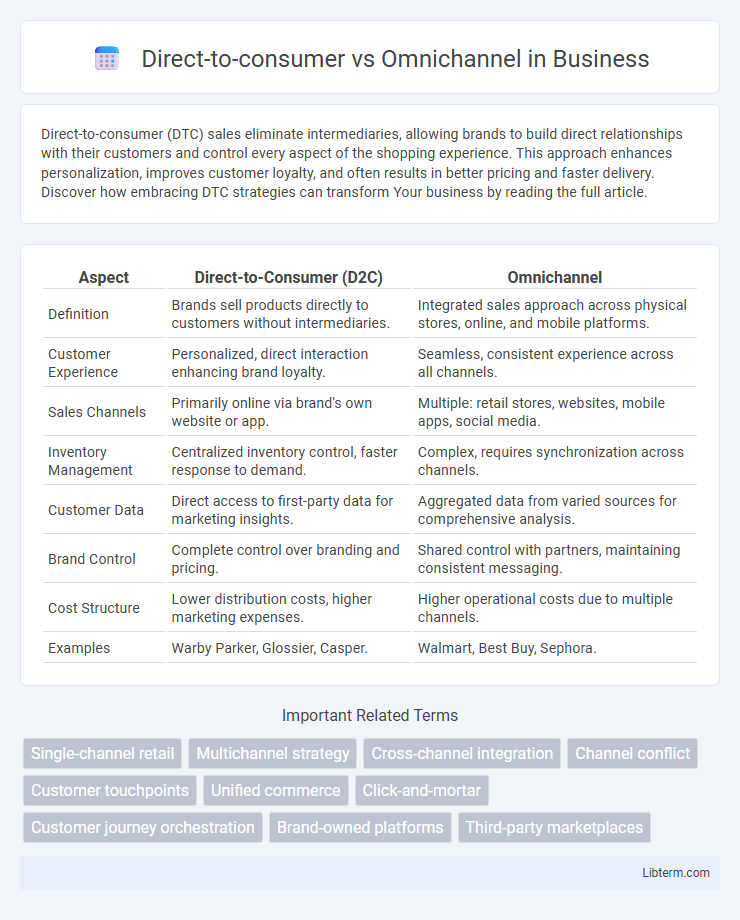Direct-to-consumer (DTC) sales eliminate intermediaries, allowing brands to build direct relationships with their customers and control every aspect of the shopping experience. This approach enhances personalization, improves customer loyalty, and often results in better pricing and faster delivery. Discover how embracing DTC strategies can transform Your business by reading the full article.
Table of Comparison
| Aspect | Direct-to-Consumer (D2C) | Omnichannel |
|---|---|---|
| Definition | Brands sell products directly to customers without intermediaries. | Integrated sales approach across physical stores, online, and mobile platforms. |
| Customer Experience | Personalized, direct interaction enhancing brand loyalty. | Seamless, consistent experience across all channels. |
| Sales Channels | Primarily online via brand's own website or app. | Multiple: retail stores, websites, mobile apps, social media. |
| Inventory Management | Centralized inventory control, faster response to demand. | Complex, requires synchronization across channels. |
| Customer Data | Direct access to first-party data for marketing insights. | Aggregated data from varied sources for comprehensive analysis. |
| Brand Control | Complete control over branding and pricing. | Shared control with partners, maintaining consistent messaging. |
| Cost Structure | Lower distribution costs, higher marketing expenses. | Higher operational costs due to multiple channels. |
| Examples | Warby Parker, Glossier, Casper. | Walmart, Best Buy, Sephora. |
Understanding Direct-to-Consumer (DTC) Models
Direct-to-Consumer (DTC) models enable brands to sell products directly to customers, eliminating intermediaries such as wholesalers and retailers, which enhances profit margins and customer relationships. This approach leverages digital platforms like branded websites and social media to deliver personalized shopping experiences and gather valuable consumer data. In contrast, omnichannel strategies integrate multiple sales channels, including physical stores, online marketplaces, and mobile apps, to create a seamless customer journey across all touchpoints.
What is Omnichannel Retailing?
Omnichannel retailing integrates multiple sales channels--such as physical stores, online platforms, and mobile apps--to create a seamless and consistent shopping experience for consumers. This approach leverages data synchronization and unified customer service across all touchpoints, enhancing engagement and personalization. Retailers adopting omnichannel strategies benefit from increased customer loyalty and higher sales conversion rates compared to single-channel or direct-to-consumer models.
Key Differences Between DTC and Omnichannel
Direct-to-consumer (DTC) models primarily focus on selling products directly from brands to customers via online platforms, offering greater control over customer experience and data collection. Omnichannel strategies integrate multiple sales channels, including physical stores, online marketplaces, and social media, to provide a seamless and consistent shopping experience across all touchpoints. The key difference lies in DTC's direct customer engagement versus omnichannel's comprehensive, multi-platform presence aimed at enhancing customer convenience and brand accessibility.
Customer Experience: DTC vs Omnichannel
Direct-to-consumer (DTC) models offer personalized customer experiences through direct interaction, streamlined communication, and tailored product offerings, enhancing brand loyalty and satisfaction. Omnichannel strategies integrate online and offline touchpoints, providing seamless, consistent customer experiences across various platforms, which boosts convenience and engagement. Both approaches prioritize customer experience, but DTC emphasizes direct personalization while omnichannel ensures cohesive, multi-channel accessibility.
Brand Control and Communication Strategies
Direct-to-consumer (DTC) models grant brands full control over their messaging, allowing for tailored communication strategies that foster stronger customer relationships and personalized experiences. Omnichannel approaches integrate multiple touchpoints, ensuring consistent brand messaging across platforms but requiring complex coordination to maintain unified control. Brands leveraging DTC can directly gather consumer insights, optimizing marketing tactics, while omnichannel strategies enhance customer engagement by blending online and offline interactions seamlessly.
Operational Efficiency in DTC and Omnichannel
Direct-to-consumer (DTC) models streamline operational efficiency by reducing intermediaries, enabling faster inventory turnover, and enhancing supply chain control. Omnichannel strategies improve operational flexibility by integrating multiple sales channels, optimizing inventory distribution, and providing real-time data synchronization across physical and digital touchpoints. Efficient order fulfillment in DTC leverages centralized warehouses, while omnichannel operations benefit from distributed inventory to meet diverse customer demand swiftly.
Technology and Data Insights
Direct-to-consumer (DTC) models leverage advanced analytics and first-party data to create personalized customer experiences and optimize marketing strategies. Omnichannel approaches integrate multiple touchpoints using unified data platforms, enabling seamless customer journeys and real-time insights across physical and digital channels. Cutting-edge technologies such as AI-driven recommendations, CRM systems, and data lakes empower brands to harness comprehensive data for enhanced decision-making and customer engagement in both models.
Marketing Approaches: DTC vs Omnichannel
Direct-to-consumer (DTC) marketing focuses on building direct relationships with customers through personalized digital channels, leveraging data-driven insights for targeted campaigns and enhanced customer engagement. Omnichannel marketing integrates multiple touchpoints, including physical stores, online platforms, and mobile apps, to create a seamless and consistent brand experience across all customer interactions. This approach maximizes customer reach and retention by combining personalized digital efforts with broader, multi-platform presence.
Pros and Cons of Each Sales Model
Direct-to-consumer (DTC) sales offer brands full control over customer experience and data, enabling personalized marketing and higher profit margins by eliminating intermediaries, but require significant investment in brand building and logistics. Omnichannel sales provide seamless integration across physical stores, online platforms, and mobile apps, enhancing customer convenience and satisfaction through multiple touchpoints, yet involve complex inventory management and higher operational costs. Choosing between DTC and omnichannel depends on business goals, with DTC excelling in customer loyalty and data insights while omnichannel drives broader market reach and omnipresent brand visibility.
Choosing the Right Model for Your Business
Choosing the right model between direct-to-consumer (DTC) and omnichannel depends on your business goals, target audience, and resource capacity. DTC offers greater control over customer experience and higher margins by selling directly via online platforms, ideal for brands prioritizing personalized engagement and data collection. Omnichannel strategies enhance customer reach by integrating physical stores, e-commerce, and third-party marketplaces, suitable for businesses aiming to maximize visibility and provide seamless cross-channel shopping experiences.
Direct-to-consumer Infographic

 libterm.com
libterm.com